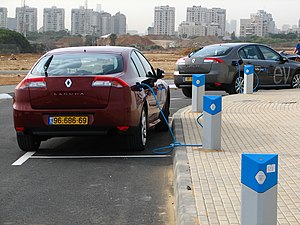 |
| English: EVs charging at the Better Place visitor centre at the Pi-Glilot former gas depot in Ramat Hasharon, Israel, north of Tel Aviv (Photo credit: Wikipedia) |
The selection of cars launched and announced at the recent Frankfurt Motor Show underlines how the electric vehicle (EV) is finally showing signs of that long-awaited breakthrough to mass-market appeal.
After earlier efforts by Mitsubishi - whose EVs are also marketed by Peugeot and Citroën - and Renault-Nissan, whose combined EV sales have now reached 100,000, BMW is launching the i3.
BMW’s effort is not only innovative for being an EV, but also in the novel use of a carbon-fibre body mounted on an aluminium chassis - a world away from mainstream automotive practice.
Tesla’s model S is also selling well from its European base in the Netherlands, with the model having just launched in the UK market.
The main European market for EVs has long been Norway, with its very generous incentives and around 15,000 EVs. But there has been significant recent growth in countries like France (20,000 EVs), Italy and to a lesser extent Germany (7,500 EVs).
The Netherlands (11,000 EVs) meanwhile is actively promoting itself as an ideal location to experiment with EVs, in view of its relatively compact size and rapidly growing charging point network.
By comparison, the UK lags behind with around 7,200 EVs, despite efforts to promote increased EV use by London mayor Boris Johnson, and government initiatives such as Plugged-in-Places funding from the Office for Low Emission Vehicles to promote the development of charging infrastructure.
The UK has around 1,700 charging stations, making up a charging network of islands with great empty seas between them. Such gaps are often filled by the local authorities - not always well publicised - or by chargers at car dealerships that sell EVs.
There is also great discussion about whether to install standard, 240v mains chargers or the much more expensive, three-phase high voltage fast chargers which come in a variety of shapes and sizes that not all vehicles can use.
The creation of a standardised plug and socket for charging is sadly lacking, leaving the EV market open to the sort of standards schism seen before in VHS vs Betamax or HD-DVD vs Blu Ray.
One suggestion is to provide some or all of the different interfaces as charging points. Software developers have created phone apps that will help locate the nearest charger - although the connector type is not always shown, nor whether it is already in use when needed.
It’s that kind of information that is important, and so is increasingly considered valuable enough in its own right to attract entrepreneurs into the charger market.
But the needs of access to space and electricity supply mean that any charger station requires buy-in from numerous organisations such as energy companies, local authorities, or private car park operators. This is frequently a barrier to rolling out new EV infrastructure.
A good example of how these barriers have been overcome is the Autolib EV car share scheme in Paris. Autolib is run by the Bolloré Group whose interest in EVs derives chiefly from their battery technology.
Bolloré won the tender to create the Autolib scheme in Paris and its 53 fellow local authorities on the Île-de-France in 2011, based on its Bluecar.
The municipalities pay €47,000 per station, to be recouped by 2014 from the fee the Autolib scheme pays for the 4-6 parking spaces at each site. Once achieved, profits will be shared with the local authorities.
The system software allows users to find a parking/charging space automatically, or via the scheme’s 24-hour call centre. An annual subscription costs €144, with tariffs for shorter periods available from €10 a day, with a small additional rate based on mileage or time.
By late 2012 the scheme had more than 13,000 annual subscriptions from a total of 37,000 subscribers.
Like London, Paris is not a car-friendly city, but renting through Autolib guarantees a parking space, for example, which can persuade drivers into the scheme. Young people with little access to a car have also become early adopters - 70% of Autolib users are in the 18-34 age group.
Autolib shows that when committed public and private interests combine for a common cause, it’s possible to make significant progress toward getting more EVs on the road. However, much of the effort in Europe is still too fragmented and on too small a scale to emulate this example.
In London, for example, while EVs have been indirectly supported by exemption from the congestion charge, there has been no joined up policy.
Now that electric cars are becoming increasingly popular and widely available, issues such as “range anxiety” - the fear of running out of power on the road - are fading into the background, but this leaves the absence of a comprehensive support infrastructure all too obvious.
Paul Nieuwenhuis has received funding from the ESRC via the BRASS research centre at Cardiff University.
This article was originally published at The Conversation. Read the original article.

No comments:
Post a Comment